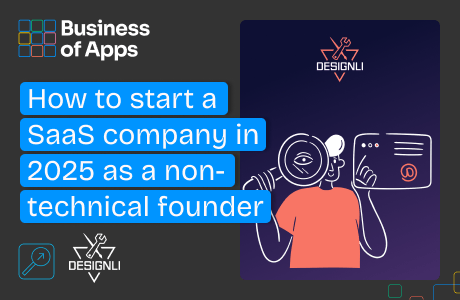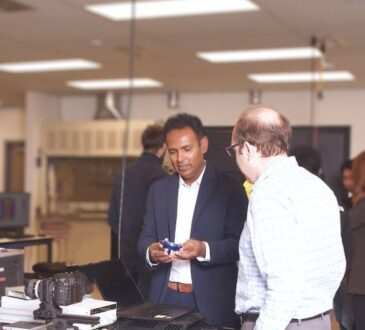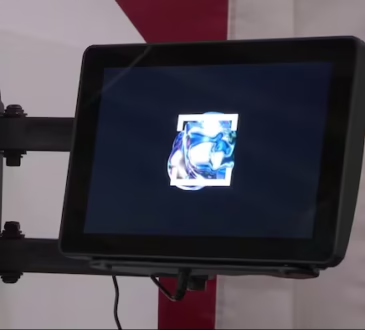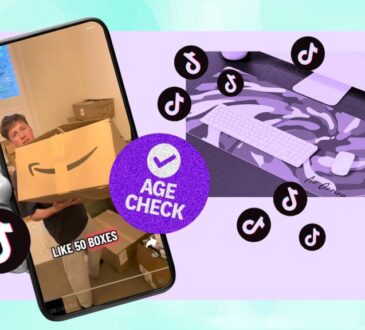
The SaaS business model remains one of the most attractive ones for founders and investors in 2025. With predictable, recurring revenue and high scalability, a well-built SaaS product can grow as far as your roadmap and market demand allow, so long as you evolve with your customers and keep churn under control.
I’ve helped hundreds of non-technical founders bring SaaS ideas to life at Designli, and one thing is clear: you don’t need to know how to code to build a successful SaaS company. What you do need is a clear process, the right mindset, and a partner who understands both your vision and the long game of product development.
A new era for non-technical founders
No-code tools have completely changed the game. In 2025, non-technical founders can test and validate ideas faster than ever without writing a single line of code. With platforms like Webflow, Lovable, Glide, and Bubble, it’s possible to build proof-of-concept applications that simulate user experience and attract early feedback, even investment.
But make no mistake: these tools are a starting point, not a strategy. You’ll need real development firepower to build a scalable, secure, and differentiated product. That means finding a partner that can make it for the long run, not just hacking together something that “works for now.”
The challenges you’ll face and how to overcome them
It’s not easy to lead a tech startup without a technical background. The biggest hurdle isn’t learning to code, but knowing how to make smart, strategic decisions in an unfamiliar landscape.
Here are some of the most common pitfalls I see:
- Choosing the wrong tech stack: Tools that seem cheap and easy up front can quickly become barriers to scaling.
- Overbuilding too soon: Adding every feature you can imagine is tempting. But building without validation often means wasted time and money.
- Misalignment with your dev team: If your developers don’t understand your business goals, you’ll struggle to prioritize the right things.
The antidote? A digital product that solves a problem with a well-structured MVP, a feedback-driven process, and a partner who speaks tech and business.
Why your MVP is your most strategic asset
Your MVP (Minimum Viable Product) isn’t just version one. It’s the first opportunity to validate your idea in the real world. For non-technical founders, it’s your most valuable learning tool and a powerful way to stay lean.
A strong MVP helps you:
- Test assumptions before heavy investment
- Collect real user feedback
- Pivot quickly if needed
At Designli, we help founders define MVPs through our SolutionLab, a two-week prototyping session that helps founders clarify their goals, map out key features, and create an interactive prototype before writing a single line of code. This isn’t just about design. It’s about business clarity.
Read our article guide with a checklist to build a successful MVP.
Build paths in 2025: no-code, custom code, or both?
Today’s non-technical SaaS founders have three viable paths to product development:
No-code/low-code tools
No-code platforms are fantastic for quickly getting an idea off the ground and on a budget. They let you present something to investors and users without hiring a full engineering team. However, they also have limits, especially regarding customization, performance, and integration with other systems, restricting product scalability.
Custom development
Custom code is the gold standard for scalability, quality, and control. If you’re building a digital product designed to grow, custom code gives you the architecture to support it. It’s a bigger upfront investment that pays off over time.
Hybrid approach
It is often the smartest move to start lean with no code or AI-generated proof of concepts, test your idea, secure early traction or funding, and then transition to custom architecture for long-term stability.
From prototype to production
Once your interactive prototype is complete, our Designli Engine kicks in. It turns your prototype into a real product with custom backend code, clean architecture, a fully owned codebase, no templates, and no lock-ins.
We prioritize:
- Backend scalability and data integrity
- Frontend usability and design consistency
- Rapid iteration cycles with continuous feedback
This is how we ensure your product is launch-ready, scale-ready, and investor-ready from day one.
Hypothesis-driven development approach
At Designli, we use Hypothesis-Driven Development (HDD) to guide our process. It’s a framework that mirrors the scientific method: form a hypothesis, test it through feature delivery, measure impact, and refine based on data.
Meaning we:
- Tie every feature to a business goal
- Use analytics and honest user feedback to validate progress
- Build out a “command center” that lets you track KPIs tied directly to development
Designli Product Owners work alongside founders to ensure every sprint moves toward a measurable outcome. We don’t build for the sake of building; we make to grow your business.
SaaS MVPs built without a technical founder
Grappos: A wine discovery platform born from a founder’s personal frustration. We helped transform a simple idea into a scalable B2B tool used by major wine brands.
AskIris: Built to optimize hospital supply rooms, this voice-enabled inventory management tool now supports multiple devices, including Apple Watch and Zebra scanners.
Cabin time: A mobile app helping families carry camp rituals into daily life. Designed for accessibility, faith-sharing, and ongoing connection post-retreat.
In every case, the founder didn’t code. They partnered smartly and built something real.
What will it cost?
Here’s the truth: launching a successful SaaS product isn’t cheap. But neither is doing it only to rebuild six months later. The smartest spend is the one that matches your build path to your long-term strategy.
For non-technical founders, the good news is there’s more flexibility than ever when it comes to how you bring your product to life:
| Approach | Pros | Cons | Estimated MVP cost |
| No-code/low-code | – Fast to prototype
– Ideal for early validation – Lower upfront cost |
– Limited scalability
– Performance tradeoffs – Often requires full rebuild later |
$1,000 – $5,000 |
| Custom development | – Built for scale and security
– Fully tailored UX/UI – Long-term tech ownership |
– Higher initial investment
– Longer build timeline |
$50k-$500k+ (varies by scope) |
| Hybrid (no-code to custom) | – Start lean, then scale
– Balance speed and control – More budget flexibility over time |
– Requires transition planning
– Potential duplication of effort |
$5,000 – $500k + |
Key costs to watch out for:
Some costs don’t show up right from the start, but they’ll hit later if you’re not careful:
- Rebuilds due to poor scalability or shortcuts
- Complex integrations lacked early planning
- Technical debt from rushed or undocumented code
Our advice: validate fast, but plan for growth. Our complete guide, which explains the cost and factors to consider when building an MVP, is available here.
Thinking beyond launch
Launching is only the beginning. A successful SaaS company evolves constantly. That means designing with scalability in mind from day one without overengineering upfront.
You’ll need clean architecture, user feedback loops, strong documentation, and an agile mindset. You’ll also need to monitor the metrics that matter, like churn, adoption, and feature engagement.
Your SaaS can grow into something much bigger than its MVP. That’s what we help founders do every day.
2025 is still your year
There’s never been a better time to start a SaaS company as a non-technical founder. Tools are better. Processes are clearer. And with the proper guidance, you can bring your idea to life faster than ever.
If you’re serious about building something that lasts, not just launches, Designli is ready to help. Schedule your consultation.
Let’s get started.





